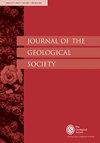巴基斯坦北部哈扎拉盆地早寒武纪粉砂岩中Tannuolina的存在及其生物地层学意义
IF 3
3区 地球科学
Q2 GEOSCIENCES, MULTIDISCIPLINARY
引用次数: 0
摘要
tommotiids是寒武纪一组重要的小壳化石,主要通过酸处理从碳酸盐岩中提取。在这里,Tannuolina丰富的孤立硬块岩是从巴基斯坦北部哈扎拉盆地东部哈兹拉组以粉砂岩为主的上部回收的。保存在粉砂岩中的tommotiid的发现不仅表明它们存在于各种沉积岩相中,而且还为在更宽的断层窗中寻找tommotiids的硬骨或硬骨组织(甚至软组织)提供了机会。巩膜炎包括两种形态,即二尖瓣型和鞍区型。经形态学比较,可确定为Tannoolina zhangwentangi Qian&Bengtson,1989。本文所示的大的二尖瓣和鞍区巩膜炎(约1cm)在尺寸增大期间表现出相对一致的形态。鞍巩膜炎可能包含两个子类型,较大的鞍巩膜炎在鞍侧有鞍,较小的凸鞍侧两侧无鞍。在原始巩膜炎中,鞍区巩膜炎的两个亚型可能合并为复合物,较小巩膜炎的重复侧附着在较大巩膜炎的鞍区上。张文坦吉首次从印度次大陆被发现,此前在中国南方以外的地方还不为人所知。哈兹拉组中上部仅含张文堂吉T.zhangwentangi,可直接与华南扇形S.ZhangWendangi组合带进行对比,代表最上寒武纪2期。这一新的古生物学发现不仅表明张文坦吉T.zhangwentangi在洲际生物地层学对比中的实用性,而且表明印度次大陆和华南之间的Terreneuvian SSF生物地层学是相当一致的,包括三个(至少两个)相关的SSF组合带(华南的Ⅰ区、可能的Ⅲ区和Ⅳ区)。此外,我们的研究结果也可能支持这两个地区在寒武纪早期的古地理联系相对紧密。专题收藏:本文是《寒武纪大爆炸进展》系列的一部分,可在以下网站上获得:https://www.lyellcollection.org/topic/collections/advances-in-the-cambrian-explosion本文章由计算机程序翻译,如有差异,请以英文原文为准。
Occurrence of
Tannuolina
in the early Cambrian siltstones of Hazara Basin, North Pakistan and its biostratigraphical significance
The tommotiids are an important group of Cambrian small shelly fossils, primarily retrieved from the carbonate rock by acid process. Herein, the abundant isolated sclerites of
Tannuolina
are recovered from the siltstone-dominated upper part of the Hazira Formation in the eastern Hazara Basin, North Pakistan. This discovery of tommotiids preserved in the siltstones not only suggests their occurrences in a variety of sedimentary lithofacies, but also provides the opportunity to look for the sclerites or scleritomes (even soft-tissue) of tommotiids in much wider taphonomic windows. The sclerites include two morphs, i.e. mitral and sellate types. Through morphological comparison, they can be identified as
Tannuolina zhangwentangi
Qian & Bengtson, 1989. The large mitral and sellate sclerites (about 1 cm) illustrated herein manifest a relatively consistent morphology during the size increasement. The sellate sclerites may contain two sub-types, the larger sellate sclerite with sella on the sellate side and the smaller convex sellate side without sella on either sides. In the original scleritome, the two sub-types of sellate sclerites probably combine as a composite with the duplicatural side of the smaller one attached on the sella area of the large one. For the first time,
T. zhangwentangi
has been recovered from the Indian subcontinent, previously unknown outside South China. The middle and upper part of the Hazira Formation exclusively bearing
T. zhangwentangi
can directly invite correlation with the
S. flabelliformis
–
T. zhangwentangi
Assemblage Zone of South China representing the uppermost Cambrian Stage 2. This new palaeontological finds not only signifies the utility of
T. zhangwentangi
for intercontinental biostratigraphical correlation, but also suggests that the Terreneuvian SSF biostratigraphy between the Indian subcontinent and South China are quite consistent, comprising of three (at least two) correlative SSF Assemblage Zone (Zone Ⅰ, possible Ⅲ, and Ⅳ of South China). Additionally, our result may also support a relatively close palaeogeographical linkage between these two regions in early Cambrian.
Thematic collection:
This article is part of the Advances in the Cambrian Explosion collection available at:
https://www.lyellcollection.org/topic/collections/advances-in-the-cambrian-explosion
求助全文
通过发布文献求助,成功后即可免费获取论文全文。
去求助
来源期刊

Journal of the Geological Society
地学-地球科学综合
CiteScore
6.00
自引率
3.70%
发文量
68
审稿时长
6-12 weeks
期刊介绍:
Journal of the Geological Society (JGS) is owned and published by the Geological Society of London.
JGS publishes topical, high-quality recent research across the full range of Earth Sciences. Papers are interdisciplinary in nature and emphasize the development of an understanding of fundamental geological processes. Broad interest articles that refer to regional studies, but which extend beyond their geographical context are also welcomed.
Each year JGS presents the ‘JGS Early Career Award'' for papers published in the journal, which rewards the writing of well-written, exciting papers from early career geologists.
The journal publishes research and invited review articles, discussion papers and thematic sets.
 求助内容:
求助内容: 应助结果提醒方式:
应助结果提醒方式:


